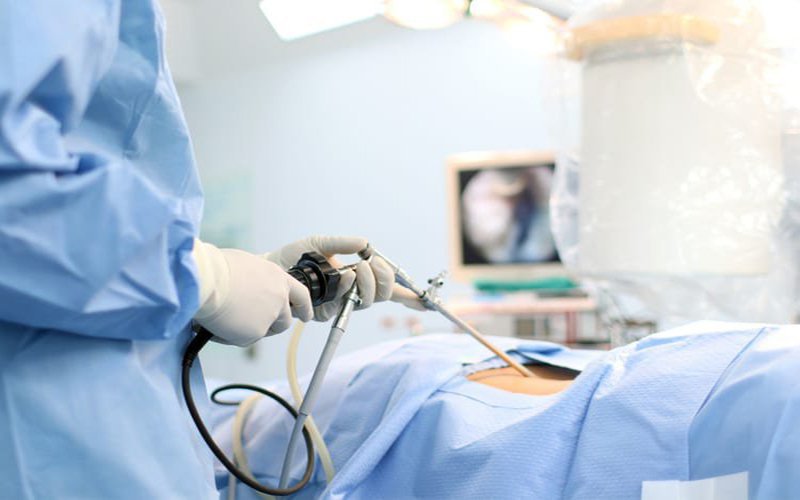What diseases can use laparoscopic surgery?
This is an automatically translated article.
Today, laparoscopic surgery to a certain extent has been gradually replacing the classical surgical method. Laparoscopic surgery has the most obvious advantage that is the small incision, much less pain.
1. What is Laparoscopic Surgery?
Laparoscopic surgery was first applied in the world in 1900 on the animal body. It was not until 1960 that this method was officially applied on the human body. In Vietnam, laparoscopic surgery has been applied in medicine since 1992.
Laparoscopic surgery is described as surgery in which doctors use an endoscope with a camera and light source to observe the side. in the patient's abdomen. Compared with open surgery, laparoscopic surgery has many advantages such as: small scar, less pain after surgery, shorter hospital stay, faster recovery than open surgery. Patients soon return to work and daily activities.

Phẫu thuật nội soi có nhiều ưu điểm vượt trội
2. Pathologies that can be operated by laparoscopic surgery
Usually laparoscopic surgery is divided into 2 types:
Diagnostic Laparoscopy After X-ray and ultrasound tests, endoscopy can be considered as a diagnostic measure thanks to direct observation inside abdominal cavity, so that the doctor can clearly know the cause of the disease and where the lesion is located.
Laparoscopic surgery Some diseases can be operated endoscopically through natural openings (nose, mouth, anus...) of the body, for example: tonsillectomy, hemorrhoidectomy... Surgery with deep lesions that cannot be performed through natural openings must use an incision opened by the doctor.
There are many diseases that can be treated by laparoscopy such as:
2.1 Obstetrics - Gynecological pathology Ectopic pregnancy Ovarian tumors Uterine fibroids Endometriosis Infertility female with fallopian tubes or polycystic ovaries Hysterectomy Urinary incontinence, lymph node dissection,... Transmuscular ring

Phẫu thuật nội soi giúp chẩn đoán các bệnh lý về sản - phụ khoa
2.2 Diseases of the Ear - Nose - Throat Endoscopic sinus surgery can interfere with every corner of the nasopharynx, from the nasopharynx to the larynx.
2.3 Orthopedic Trauma Pathology Herniated Disc Disease Cartilage or ligament disease in shoulder and knee joints 2.4 Urology Disease Endoscopic stone removal, with almost all small stones being removed from the body by endoscopy. Lower urethral stones Bladder stones Lower ureteral stones Kidney stones (endoscopy at the patient's backside). Prostate enlargement: Endoscopic prostatectomy. 2.5 Digestive Diseases Cholecystitis Inflammatory appendectomy, intussusception. Endoscopic resection of small bowel tumors, large bowel tumors Gallstones of bile ducts, liver, pancreas, spleen...

Phẫu thuật nội soi các bệnh về tiêu hóa
3. Complications can be encountered in laparoscopic surgery
Generally, laparoscopic surgery is considered safe, but there are risks and complications like any other surgery. Before surgery, it is necessary to weigh the benefits of laparoscopic surgery with the risk of complications to choose the most appropriate surgical method. Complications in laparoscopic surgery are also common complications like in other types of surgery:
Accidents caused by anesthesia, breathing tubes, drug allergies, cardiopulmonary diseases. Incisional wound infection Bleeding Thrombophlebitis, pulmonary embolism caused by a blood clot in the blood vessel. Special complications in laparoscopic surgery:
Injury to the abdominal wall causing bleeding, herniation of the abdominal wall Injury to the organs in the abdomen (intestines, bladder, large blood vessels...) The transition from laparoscopic surgery to surgery Open surgery is not a failure of laparoscopic surgery but is intended to make surgery safer.
4. Doctor's advice after laparoscopic surgery
After endoscopy, the patient should be moved very gently. The patient who can walk should walk gently, avoid vigorous activity, avoid carrying heavy objects. Follow the rules of aseptic technique for the patient. Follow infection prevention practices for caregivers. Use antibiotics and pain relievers as directed by your doctor. Ensure adequate nutrition. Pay attention to the foods that should be avoided for those who have wounds. Create a happy atmosphere for the patient to recover better. Vinmec International General Hospital with a system of modern facilities, medical equipment and a team of experts and doctors with many years of experience in neurological examination and treatment, patients can completely rest in peace. examination and treatment center at the Hospital.
To register for examination and treatment at Vinmec International General Hospital, you can contact Vinmec Health System nationwide, or register online HERE.
MORE
What is Laparoscopic Surgery? Why is laparoscopic surgery more and more popular? What disease does endoscopic sinus surgery treat? Laparoscopic surgery to remove ovarian cysts
This article is written for readers from Sài Gòn, Hà Nội, Hồ Chí Minh, Phú Quốc, Nha Trang, Hạ Long, Hải Phòng, Đà Nẵng.





